FEATURES|COLUMNS|Dharma Eye (inactive)
Attending the Kalachakra
Buddhistdoor Global | 2014-10-03 |
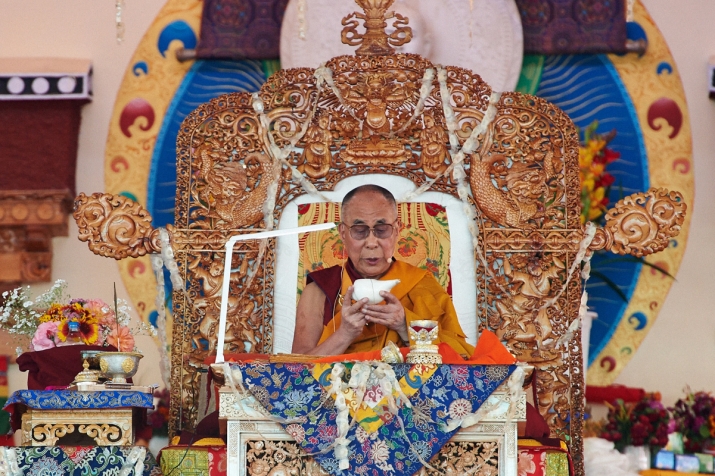
It was 3 July 2014. I was in transit at Indira Gandhi Airport in New Delhi when a stormy weather announcement was made for the Himalayan region of Ladakh, and my flight to Leh, the capital, was canceled. Just as disappointment threatened to overtake me, an inspiring figure appeared in the boarding area: Khandro-la (the recognized Tseringma oracle for HH Dalai Lama), accompanied by three monks, about to board another flight to Leh. In fact, we were both en route to attend the 33rd Kalachakra (or “Wheel of Time”) empowerment, to be given by HH the Dalai Lama in Ladakh! Meeting this dakini when in the midst of uncertainty was a veritable blessing: her pure smile gave me the strength to deal with the changing conditions and await the next possible flight with equanimity.
The next day, as I flew over the Himalayas, I could sense the emotion of the Tibetan passengers looking down at their homeland from high above. During the flight, I tried to imagine the crowd of more than 100,000 people that would be in Leh attending the Kalachakra, and the thought of being surrounded by such a large number of people made me somewhat nervous. Indeed, the Jiwatsel site was huge, and was covered by miles of green fabric to protect devotees from the sun. In fact, around 150,000 people had come for this year’s Kalachakra. Everything was perfectly organized. With the help of nearly 10,000 volunteers, the organizers managed to maintain a very calm and relaxed atmosphere, even with so many people moving in and out of the ceremony grounds.
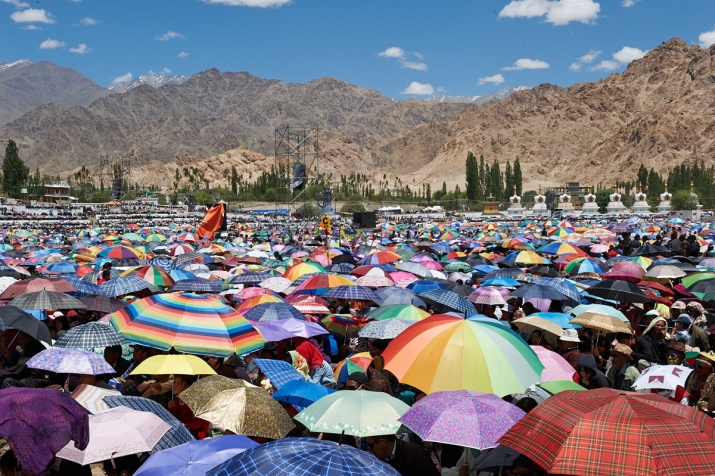
For three days, we attended the preparations for the Kalachakra empowerments and witnessed the making of the sand mandala by the monks of Namgyal Monastery. It was wonderful to hear their prayers and chants while the colored sand was poured in the presence of HH Dalai Lama, who was fully engaged in the practice. When the mandala was finished, His Holiness made three circumambulations around it and placed flower petals in the corners, followed by monks offering tormas (ritual food offerings) and vases of flowers. On completion of the ritual, the mandala house was closed off. The crowd witnessed this in reverent silence, filled with emotion at this precious, powerful moment!
Parallel to this, His Holiness gave preliminary teachings on two texts by Nagarjuna, “The Precious Garland” and “Letter to a Friend.” He pointed out that Tibetan Buddhism is grounded in the Nalanda tradition, which is based on reasoning, and advised us to adopt a similarly inquisitive approach, instructing that of the three practices, the most important is wisdom, supported by concentration and morality.
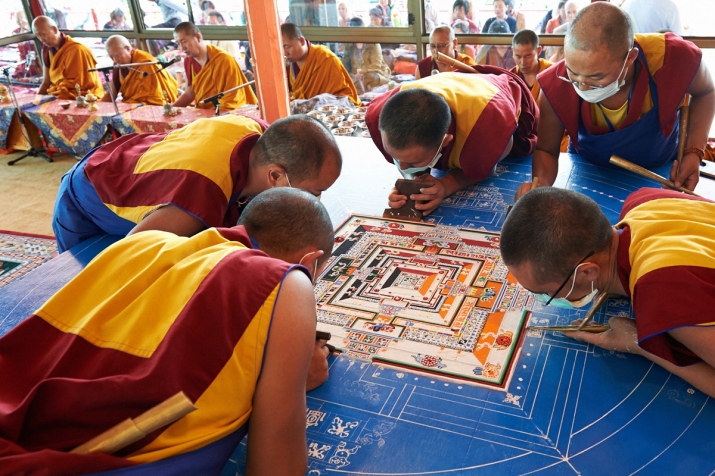
His Holiness remarked that while the Buddha’s body, speech, and mind have many qualities, his predominant qualities are love and compassion. As such, Buddhism can be described as a system based on compassion. The bodhisattva path, which involves both compassion and wisdom, is the means by which one can attain enlightenment. All good comes from compassion, and all drawbacks are the result of cherishing oneself above others.
He reiterated that to protect us from suffering, the Dharma advises us to refrain from harming others and instead, to help them by practicing the ten virtuous actions.* Suffering is not dispelled by reciting prayers, but only by overcoming ignorance. That is why it is so important to study and live in religious harmony, maintaining deep respect for all traditions.
On 9 July, we witnessed a traditional meditative dance performed by 12 Namgyal monks wearing lotus crowns, brocade costumes, and bone ornaments, each dancer holding their vajra and bell. It was like a refreshing gift in the sweltering heat of the Ladakhi summer sun!
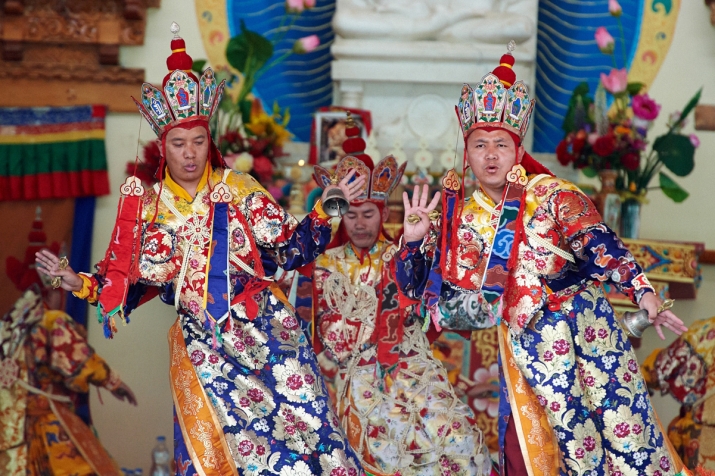
The Kalachakra empowerment was ready to begin. His Holiness explained that no matter what religious tradition we follow, no matter what different customs we engage in or languages we use, what we all want is happiness. And yet to actualize happiness, a clear, keen understanding of the mind and its workings is fundamental. In Buddhism, mind is considered to be of the nature of clear light. All sentient beings have such a mind of clarity, and the practice of Kalachakra gives us a means to become aware of this clear nature of mind. The basis for the empowerment is a preliminary understanding of emptiness and a sense of compassion, bodhichitta, from which we can accomplish a transformation within ourselves. Just as we take medicine to overcome sickness, we need to practice the Dharma for our negative emotions to lose their grip.
The ritual was very powerful and had a deep impact on me. With a torma offering, in a solemn voice His Holiness requested the “obstacle-makers,” in other words any forces that might hinder the empowerment, to stay away, and created a vajra fence around the place where the empowerment would occur. After this, he gave both the lay and bodhisattva vows, and advised the students to place some kusha grass under their pillows to increase the potential for clear, auspicious dreams.
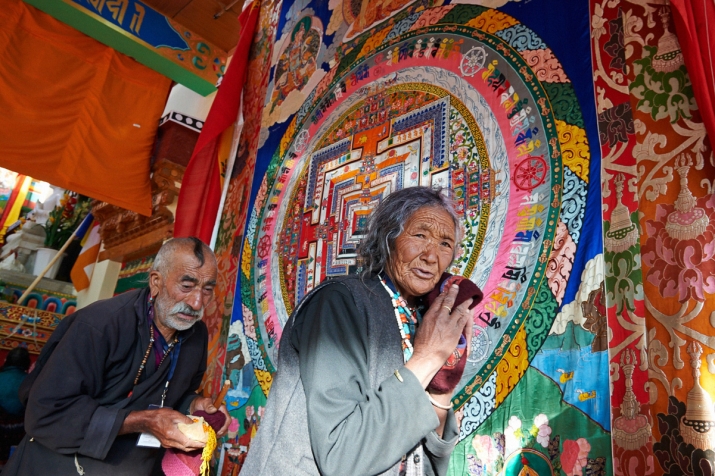
The following day we were all invited to enter the luminous Kalachakra mandala as blessed guests, visualizing first the eastern gate, the entry point into the palace of the deity. It was like watching a movie within! Following His Holiness’s precise instructions we were able to see the three dimensions of body, speech, and mind in unity, displayed as a perfect, three-dimensional “world” in order to reactivate the luminous nature of our minds. This experience was very intense and colorful as well as meaningful!
The next day, during the full moon, the eleven empowerments of the Kalachakra mandala were given. My mind was still traveling in the mandala, illuminated by the details His Holiness had so precisely described. I was very impatient, and wanted to pay homage at the sand mandala right at the same moment as the thousands of other devotees . . . Finally, I was able to pay homage to the Great Mandala. Circumambulating the mandala, its purity and perfection brought me to tears. I realized this Wheel of Time was deep in me, in my heart, so clearly drawn. I felt that the Kalachakra empowerment had begun to have its effect!
Now, it remains to practice as instructed, so that Kalachakra can accompany me and make its wheel turn in me, moment by moment.
* The ten virtuous actions consist of abandoning the ten negative actions: 1. Not taking life; 2. Not taking what is not given; 3. Avoiding sexual misconduct; 4. Not lying; 5. Avoiding slander; 6. Avoiding harsh speech; 7. Avoiding empty speech; 8. Avoiding avaricious thoughts; 9. Not being malicious; 10. Avoiding wrong views
Olivier Adam is a member of Dharma Eye—The Buddhist Photographer Collective. For more on Dharma Eye and Olivier’s work please visit: http://www.dharmaeye.com.

Comments:
Share your thoughts:













